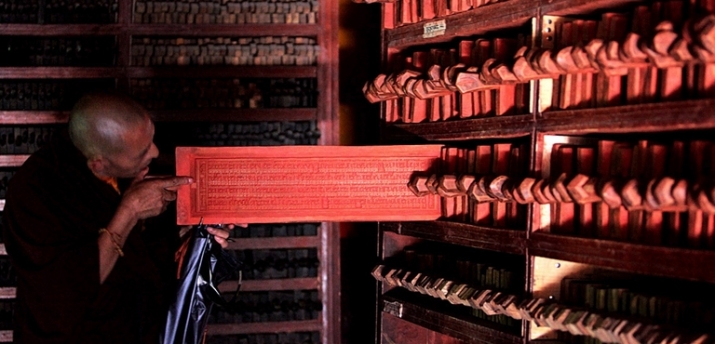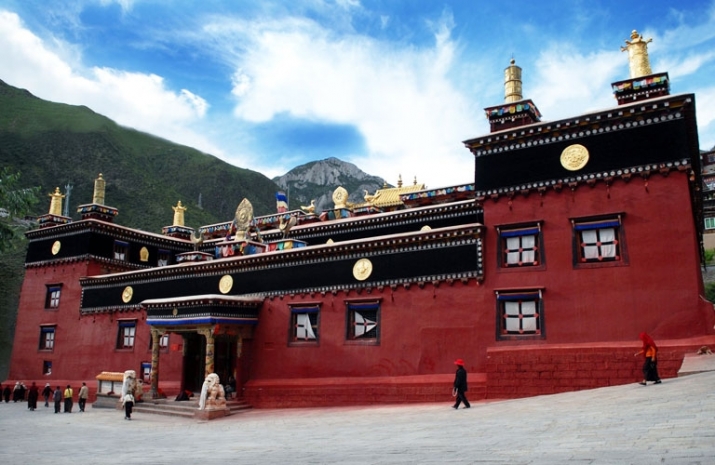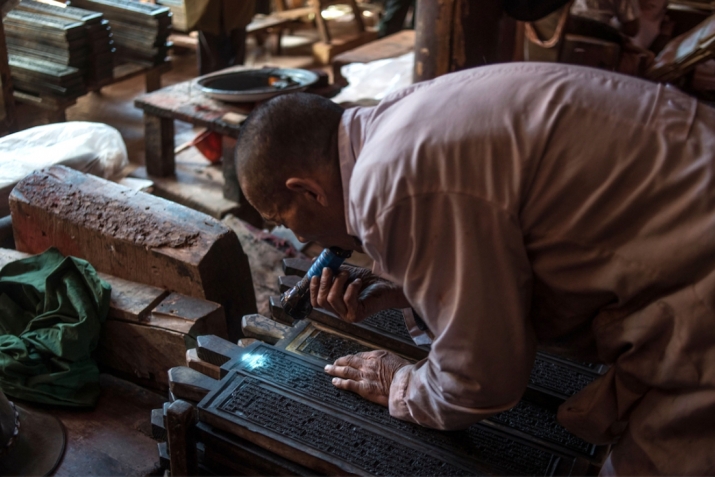NEWS
Resilience and Devotion: Ancient Tibetan Wood Blocks Keep the Sutras Alive
 A library of wooden blocks ready for printing. From chinadiscovery.com
A library of wooden blocks ready for printing. From chinadiscovery.comIn the town of Derge (also Dege), a typical Chinese city filled with modern five-story buildings and glowing neon signs in the heart of the traditional Tibetan region of Kham on the eastern edge of China’s Sichuan Province, lies the Dege Parkhang sutra printing house. Here a dedicated group of Tibetan Buddhists is working with patient devotion to preserve one of Tibet’s ancient traditions: the hand printing of sutras using traditional wooden blocks made from locally sourced materials.
The printing lamasery dates from 1729 and was commissioned by the 12th headman and 6th dharma-raja (King of law) of Dege, Chokyi Tenpa Tsering. Today, it is one of the most revered pilgrimage sites on the Tibetan Plateau. The three-story lamasery is hard to miss with its many visitors, deep red walls, and gold-topped roof.
 Dege Parkhang sutra printing house. From chinadiscovery.com
Dege Parkhang sutra printing house. From chinadiscovery.comThe old lamasery is home to numerous cultural and religious relics, such as the many murals, paintings, and sculptures housed in the sutra-printing hall, ancient instruments, thangka paintings, and a large collection of printed sutras and scriptures, including a large number of ancient Tibetan manuscripts from a wide range of Tibetan Buddhist schools (the aforementioned founder of the monastery—Chokyi Tenpa Tsering—was very broadminded). Most notable is its collection of 320,000 wooden printing blocks, most of which are several centuries old. Despite their age, some of these wooden blocks are still used on a daily basis as the lamasery has a working printing house; the Dege Parkhang sutra printing house. Here some 60 employees print around 2,500 double-sided sutras on a daily basis using traditional woodblock printing techniques, even producing the ink and paper themselves from locally sourced materials. The prints they produce are then circulated across the Tibetan plateau and used by the monks in neighboring monasteries.
In addition to preserving the centuries-old printing blocks, the lamasery also cuts or recuts new blocks. This is done in strict accordance with The 40 Standards of Tibetan Calligraphy by Chionpo Yuchyi and Rongpowa—two of Derge’s most famous calligraphers. The wooden blocks start their life as pieces of locally sourced red birchwood, which are soaked in feces for six months, before undergoing a process of drying, fire-curing, boiling, baking, and finally, planning, and cutting.* The entire process of cutting new blocks is divided into 13 steps, and each block is proofread 12 times before being used.
When it comes time to print, the workers are divided into pairs and seated facing each other, bending over the thin wooden print blocks. One man covers the block in red or black ink, then the other places a thin piece of paper atop the block, bending further to firmly press the paper onto the wooden block with a roller. The completed print is then removed and taken away to dry.
During its peak, the printing press would have employed more than 500 monks from the neighboring Gonchen Monastery. Nowadays, however, all the 60 employees are laypeople, who diligently work for a very meager pay. Pema Chujen, a Tibetan woman who shows visitors around the lamasery, explained this devotion, describing the bending required when the workers print the scriptures onto the blank paper as act of prostration to the Buddha. “This is just the faith in their hearts,” she said. “Of course, it’s good to make offerings to the Buddha using a lot of money, but it’s more faithful to make offerings using your body, mouth, and mind.” (The New York Times)
 Each block is proofread 12 times before being used. Photo by Gilles Sabrié. From nytimes.com
Each block is proofread 12 times before being used. Photo by Gilles Sabrié. From nytimes.com* http://www.degeparkhang.org/dege-gy-en.htm
See More
Printing the Ancient Way Keeps Buddhist Texts Alive in Tibet (The New York Times)
Dege Parkhang Sutra-Printing House (Dege Sutra-Printing House)
Related news from Buddhistdoor Global
Chinese Buddhist Texts on Display as Examples of Early Block Printing
The Prince’s School of Traditional Arts Exhibits Buddhist Chinese Traditional Woodblock Prints
Related features from Buddhistdoor Global
A Small Buddhist Prayer-flag Factory in Bir
Printed Prayers: Japan’s First Woodblock-printed Buddhas
The Making of Buddhist Wood Sculptures in China
Visions from the Zen Mind: Zen Paintings and Calligraphy at the Los Angeles County Museum of Art














